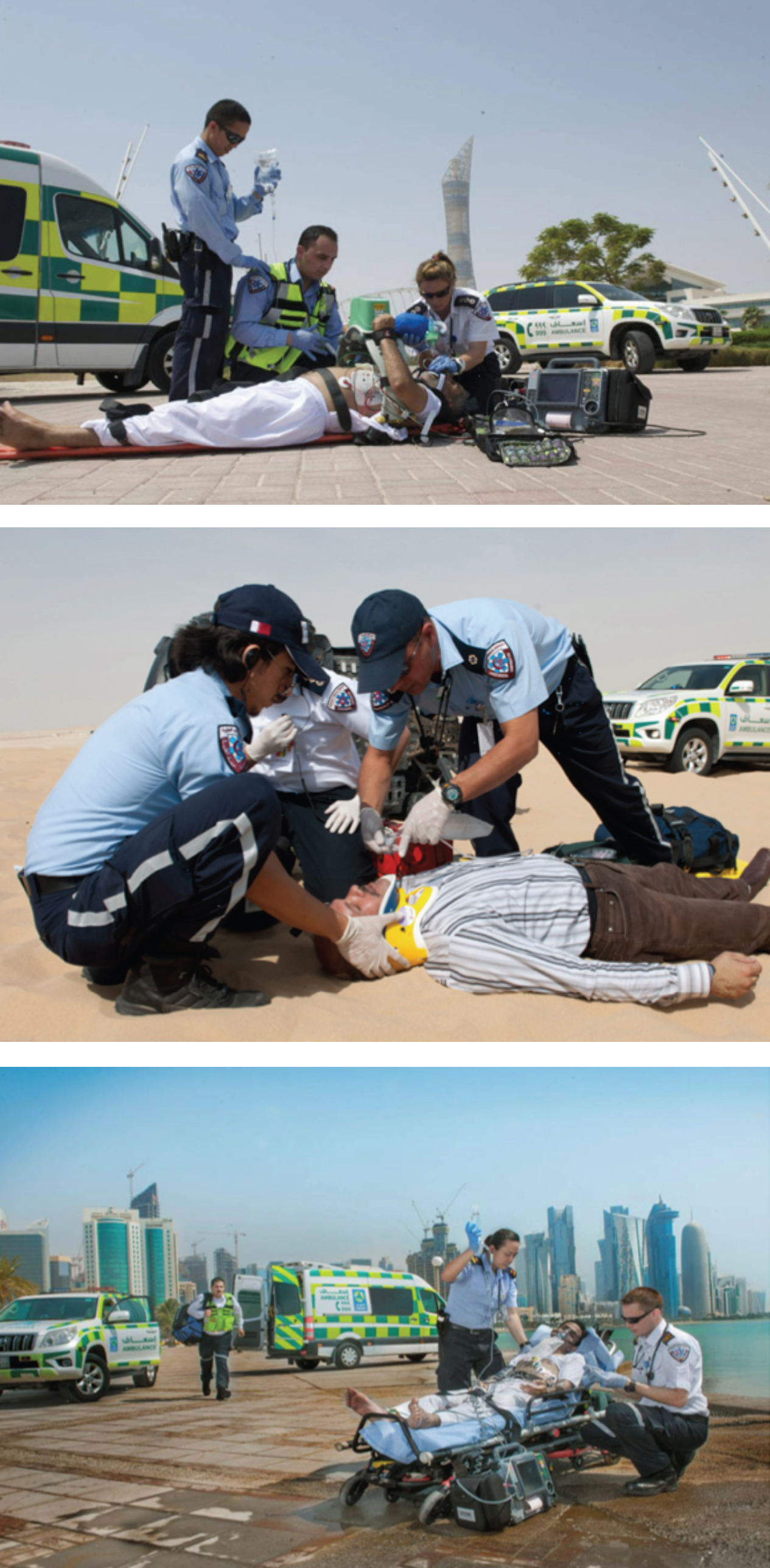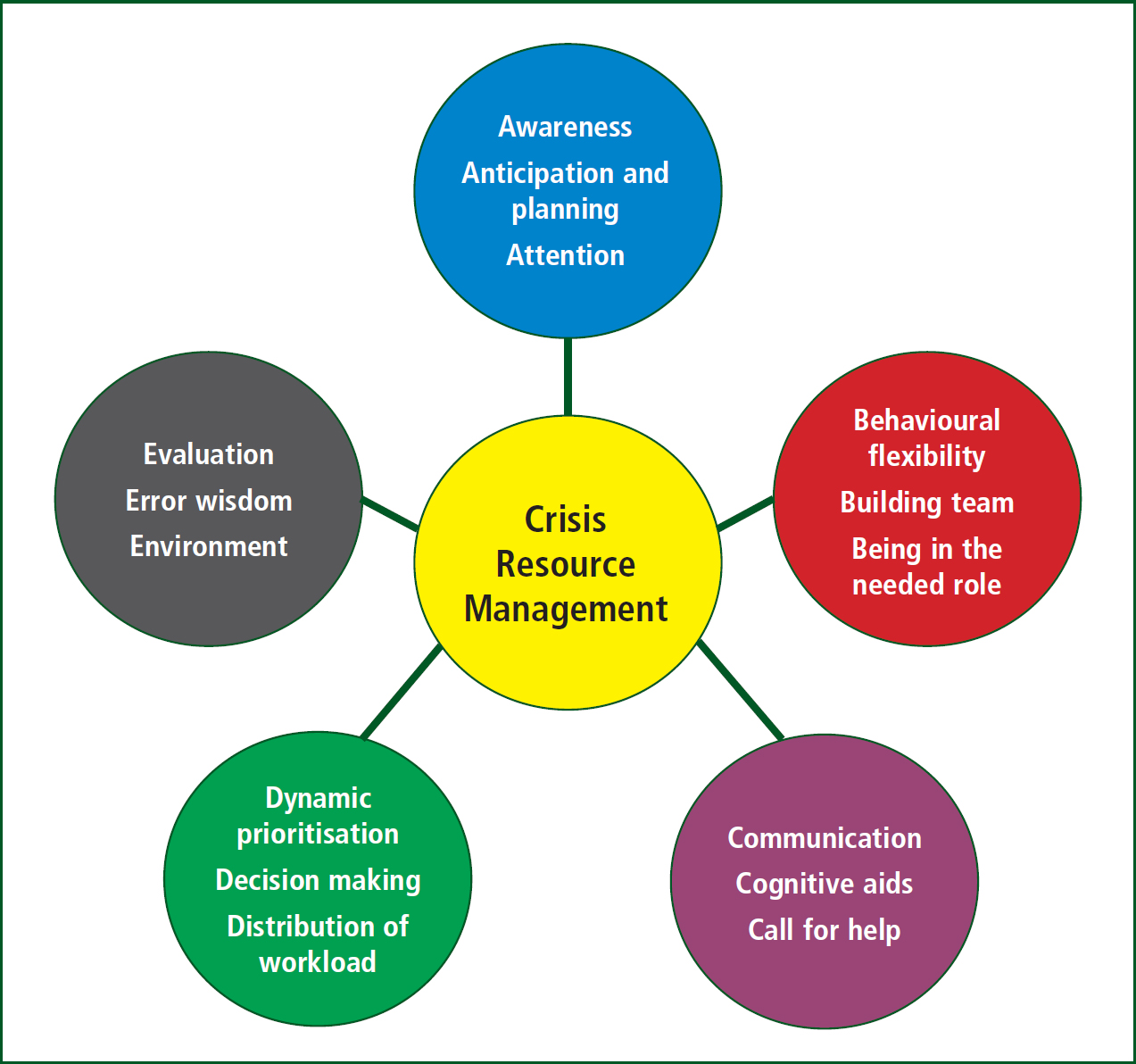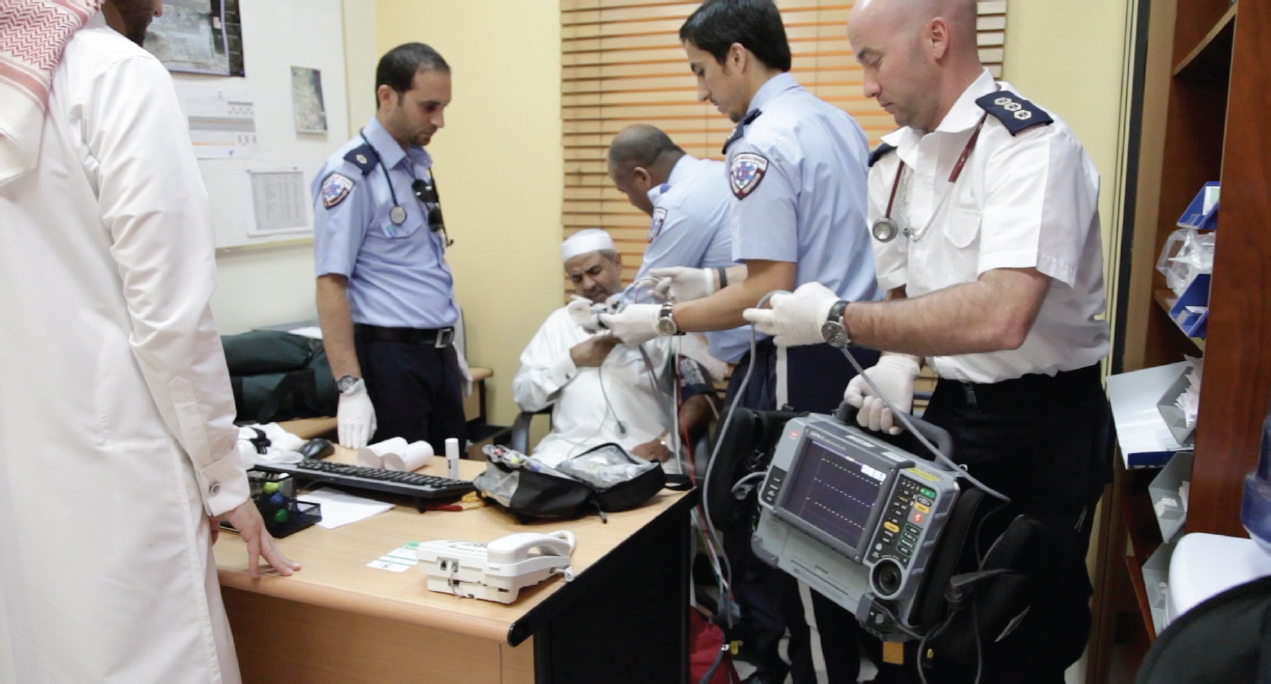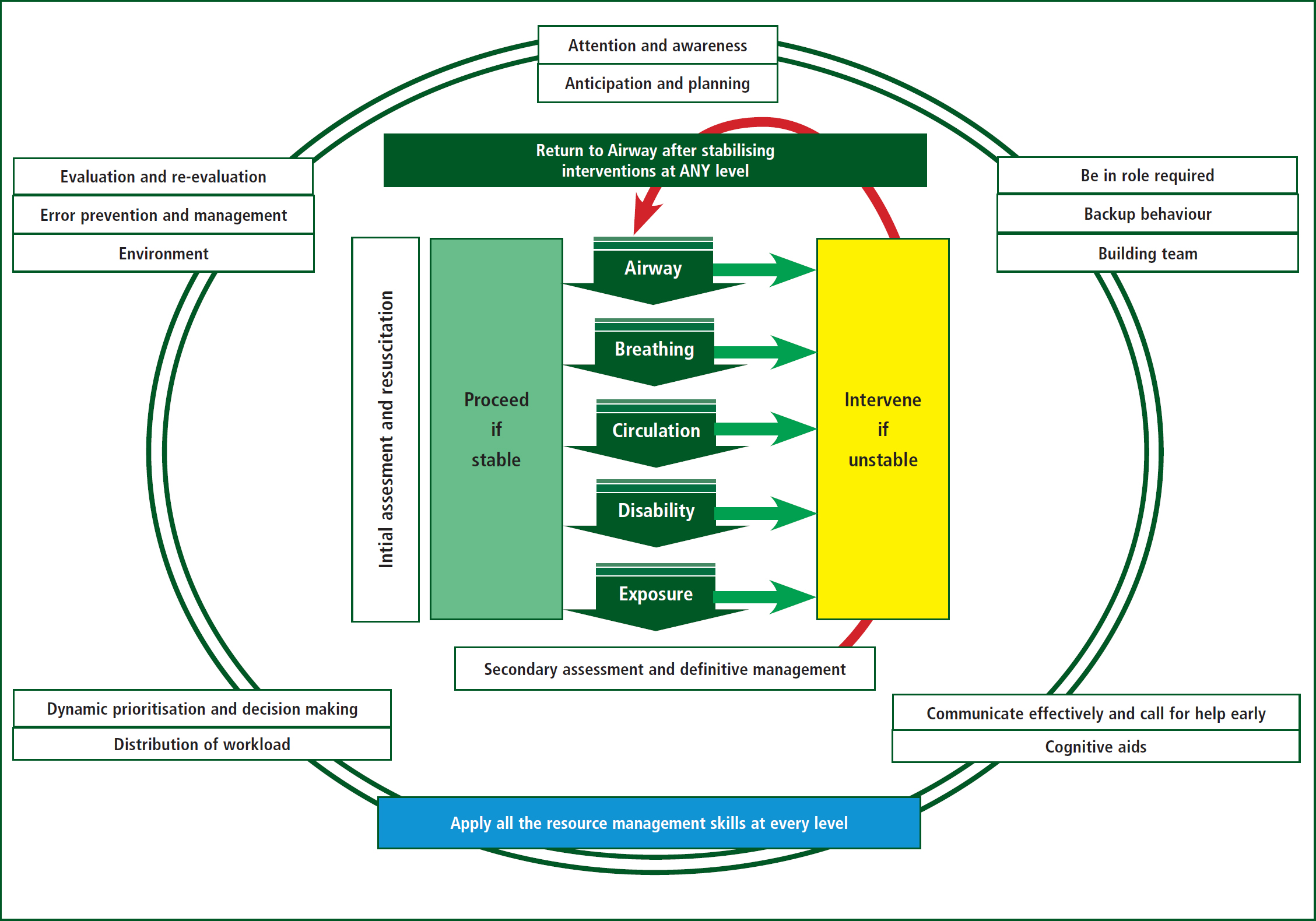There is increasing recognition that the successful management of medical emergencies, in the hospital or pre-hospital care setting, depends on the non-technical skills as well as the technical skills of the people involved. The inseparable nature of these two sets of skills in determining the outcome is especially evident where the demands outweigh the available physical and/or psychological resources, and the situation reaches a crisis point. A crisis is defined in the Oxford dictionary as a time of great difficulty or danger where an important decision must be made. For the purpose of crisis resource management (CRM) in the medical context Lighthall (2008), uses the definition:
‘An unplanned life-threatening event in which there is a mismatch between the ambient level of resources and those that a patient needs to regain stability.’
In their excellent account of the origin and evolution of CRM in health care education and in the provision of health care across multiple domains and a detailed working knowledge, Fanning et al (2013) describe CRM as:
‘The articulation of the principles of individual and group behaviour in ordinary and crisis situations that focuses on skills of dynamic decision making, interpersonal behaviour, and team management.’
It is further described as:
‘A system that makes optimum use of all available resources (equipment, procedures, and people) to promote patient safety. It is a concept that sits within the large organisational framework of education, training, appraisal, and refinement of processes at both a team and individual level.’
It has been reported that team-based concepts such as CRM, human factors, and ergonomics principles can be challenging, overwhelming, and confusing (Sexton et al, 2000). Any aid to overcome the barriers in helping healthcare professionals apply these skills in the clinical practice is likely to have a significant impact on promoting patient safety.
Role of simulation in developing non-technical skills
CRM skills were initially identified for specific training in aviation and adapted to be incorporated in medicine over two decades ago (Gaba et al, 2001). Significant progress had been made in mapping the different components of the non-technical skills and applying these principles in various branches of medicine (Murray and Foster, 2000; Flin and Maran, 2004; Sunder et al, 2007). The extensive process undertaken for the development of these tools included incident data, interviews with experts, and sound industrial psychology methods.
Non-technical skills are as relevant for paramedics in the pre-hospital care environment as they are to the multiprofessional or multidisciplinary team who treats the patient in a hospital. Involvement of healthcare professionals from various disciplines as a team, both during undergraduate and postgraduate education, enables the early introduction of team concepts and retention of such skills by the practitioners (Alinier et al, 2014). Scenario-based simulation is increasingly used as a learning modality for healthcare practitioners to familiarise them with the application of these concepts or principles and quality improvement initiatives in healthcare (Alinier and Platt, 2014).
Enabling recall of non-technical skills
An effective method of learning how to respond to an emergency is to use a mnemonic strategy as it has been shown to be useful at improving memorisation (Collins, 2007). A mnemonic can be a word or specific succession of letters that is used to assist memory. Mnemonics can be used to remember critical steps during stressful times when recall might be impaired, such as during the resuscitation of a neonate (Fernandes and Speer, 2002). It is suggested that mnemonics can promote efficient memorisation and easier access to memory because of their novelty or familiarity (Beitz, 1997).

A simplified system to enable a structured ABCDE approach has proven to be very successful in training the necessary technical skills in life support courses (Thim et al, 2012). Although the need for a consistent approach when applying this strategy and the use of the same ‘language’ to promote simplicity and to avoid confusion is recognised (Guly, 2003), the value of such a system in managing emergencies is well established (Runciman et al, 2005).
This article describes grouping the key non-technical skills into a similar ABCDE format as the one used in life support technical skills training to enable easier recall.
Introduction of a CRM mnemonic
The practical application of CRM principles and their role in promoting patient safety is well published, especially in anaesthesia and critical care (Rall and Dieckmann, 2005; Rall and Gaba, 2005). The CRM principles can be derived into 10 to 15 points. These points can be grouped alphabetically in twos or threes, which is an easily memorable format. The success of such grouping of keywords under the same letter of the alphabet is evident in the incorporation of the well known four Hs and four Ts of potential reversible causes highlighted in the resuscitation algorithms (Soar et al, 2010). The following, also shown in Figure 1, is the result of the alphabetical grouping of the core CRM points with a corresponding outline of the key concepts.

Awareness; Anticipation and planning; Attention
Awareness includes self-awareness and situational awareness. Anticipation and planning will minimise the chance of events developing into crises leading to negative or worst patient outcomes. Knowing the environment and the system within which one operates is essential for planning and preparation. Wise allocation of attention is an essential component during the management of a crisis, as the dynamic nature of crisis situations demands constant vigilance and anticipation. In the prehospital care setting, the environmental variability can be particularly challenging and the only certainty of the knowing the environment aspects might be confined to the paramedic knowing their constant environment that is created by the ambulance and their response bag and equipment.
Being in the role required; Building teams; Backup behaviour
Being in the role required as the leader or follower will give the best opportunity to get the most of the team members' competencies. It demands behavioural flexibility during professional interactions. The synergistic effects of constant efforts to build and maintain a team from every member is most likely to produce a favourable outcome for the team dynamics, and ultimately the higher probability of a positive patient outcome.
Communicating effectively; Calling for help; Cognitive aids
Communicating effectively and in a structured manner to get the specific help needed is also a critical element of CRM. It includes Calling for help early, which demands being aware of the current situation, available resources, and their anticipated contribution in resolving the situation. Cognitive aids, such as drug dose tables and mini protocol cards, minimise reliance on human memory which is likely to fail during a crisis. Using such visual aids is likely to result in the utilisation of all the available information and resources, and the rapid initiation of the appropriate treatment.
Dynamic prioritisation; Decision making; Distribution of workload
Skillful execution of the above leadership and followership qualities demands disciplined training to develop. However, the complexity and the constant need for a change in roles requires every member of the team to be aware of the processes and the impact on the management of the crisis situation. As a situation is continuously reassessed, significant changes may be noticed that warrant a plan of action being modified. This relates to the dynamic prioritisation aspect of CRM. Workload distribution is an effective process of sharing tasks and procedures that need to be performed, such as initiation of treatment, calling for help, and supporting one another.
Evaluation; Error wisdom (Reason, 2004); Environment
Evaluation and repeated re-evaluation facilitates obtaining a bird's eye view and tracking progress. A systematic sequential approach is required for the successful and safe application of the technical skills, and it often demands regular re-evaluation, especially after an intervention at any level. Being aware of the potential for and the nature of errors will help prevent and deal with them effectively. Error wisdom is positively affected by reflection practised by healthcare professionals based on their clinical experience (Iedema, 2011). This can also be linked to the importance of knowing the environment and individuals' abilities to regularly re-evaluate it in its broadest context to prevent or at least minimise errors.
Using the CRM mnemonic and its graphical representation
One of the main differences in applying the non-technical skills compared to that of technical skills is the sequential nature of the systems approach used to ensure institution of life-saving measures during initial assessment and resuscitation, by prioritising systems and pacing progression to the next system.
Such a listing in order of priority of CRM principles seems arbitrary because of their inter-relationship and the need to consider and implement them at each level, while providing treatment to a critically unwell patient or responding to a crisis or difficult situation. This means that non-technical skills need to be applied in each sequential step in a simultaneous manner, and in each step there is a need to be aware of all the aspects of the non-technical skills relevant to resource management. The process of the implementation of these skills is better represented as a radial diagram where the principles are shown as elements of equal importance related to the core element and will appear in each hierarchical step of technical skill application.

The integrated approach combining the clinical components of the system based approach with the acute crisis resource management (ACRM) points incorporated at each level is shown in Figure 2. It clearly illustrates the iterative process of the traditional ABCDE algorithm, while also emphasising the perpetual importance of the CRM principles at every step of that process to ensure effective and safe teamwork and provision of care.

Discussion
The realisation of the importance of the non-technical skills has stimulated the development of systems to implement these in clinical practice. Anaesthetists' non-technical skills (ANTS) and non-technical skills for surgeons (NoTSS) are such examples (Moorthy et al, 2006; Patey, 2007; Yule et al, 2008). These systems have developed comprehensive lists of behavioural markers to assess and train in non-technical skills. Similarly the TeamSTEPPS programme (Agency for Healthcare Research and Quality, 2007) incorporates these principles and makes good use of mnemonics as memory aids for most of the communication tools they promote (e.g. SBAR, CUS, DESC, STEP, IMSAFE) (Henriksen et al, 2008).
The successful incorporation of the system in life support training and its translation into clinical practice is testimony to a simple ABCDE approach. The use of a similar approach to represent the key concepts of equally important CRM principles is likely to enhance easier retention and recall, and hence their actual application during everyday patient care.
We depicted the key non-technical skills as a radial diagram to represent the nature and application needs of the various components and to minimise the potential for confusion arising from using the same mnemonic approach to represent both set of skills. When combining the ABCDEs representing both sets of skills into a diagram, the true nature of both approaches and their dynamic interaction becomes evident (see Figure 1). Such an integration using a variety of mnemonic and visual aids is likely to promote successful application of theory into practice. As a result there is an increased potential for the different techniques to match the learning styles of a greater variety of learners or healthcare professionals.
The potential initial use of this aid is in full-scale scenario-based simulation so learners can familiarise themselves with it in a safe environment with protected time for reflection and clarification. At the beginning of the simulation session, the principles underlying the integrated approach can be introduced to the learners using Figure 1. During scenarios, relevant notes regarding the different skills and principles can be taken by observers or faculty in the appropriate area of the figure to help cover all the important points during debriefing or to provide feedback to the learners.
An alternative for those who would prefer a checklist is to construct a matrix using the technical ABCDEs on one axis and the non-technical ABCDEs on the other axis. Such a template allows notes to be written in the appropriate boxes during a scenario.
It is important to consider the potential barriers for the use of any cognitive aid in an emergency; its accessibility, presentation, perceived usefulness, and acceptance.
Although simulation-based training provides a proven way of educating and training staff, the investment potentially required to facilitate such experience may not be available to everyone. The concepts can be introduced using desktop or mental simulation in the classroom setting and with small group discussions.
We believe a simple visual representation of the skills closely representing the application nature is a useful tool to introduce the concepts and also as a tool to reflect on after simulated scenarios or after managing patients in clinical practice. These alternative approaches are useful to introduce the key CRM concepts and provide a significant impact, and do not require significant investment in terms of cost of training or time away from clinical duties as it can be delivered in the work setting. Exercises can be verbally practised between paramedics inside the cabin of their ambulance while on standby.
The core principles remain constant and will provide a foundation to build on and to understand the emphasis on the comprehensive non-technical skills training specifically available for different groups of clinicians such as paramedics, nurses, surgeons, anaesthetists and scrub practitioners, to only site a few examples.
The effectiveness of the use of the proposed model should be tested by following up healthcare professionals with varying levels of experience, as well as undergraduate healthcare students who received simulation-based training or other forms of training using the various systems presenting CRM and non-technical skills.
Conclusions
Building on the success of a simple structure, we are proposing the use of a mnemonic as an aid to remember the sequence in which to manage emergencies or difficult situations while ensuring effective and safe teamwork. This approach is likely to help embed the use of the CRM principles in clinical practice and is likely to increase patient safety.
The evidence base needed for widespread adoption of this tool will require the willingness and support of those involved in simulation-based education to incorporate this in CRM and non-technical skill training courses, and to compare prospectively the adoption of CRM principles with the courses that have used the previous tools. Ultimately, like it is the case in aviation, CRM should be a core component of healthcare education across professions and disciplines.

